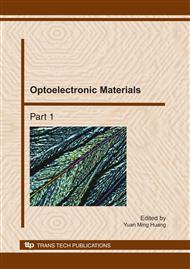p.113
p.118
p.125
p.129
p.133
p.137
p.141
p.146
p.150
Synthesis and Luminescent Properties of a New Green Phosphor CaO:Tb3+,Li+
Abstract:
CaCO3 was chosen as main raw material and wet chemical method was used to prepare the precursor. The precursor was directly sintered at 1060oC with reducing atmosphere for 3 h to obtain new green CaO:Tb3+ ,Li+ Phosphors. The effects of the content of the doping ions Tb3+ and Li+ on the luminescent properties have been studied. The structure, morphology and luminescent properties of the phosphors were characterized by XRD, laser particle size analyzer, SEM, UV and PL-PLE spectra respectively. The results showed that the CaO:Tb3+,Li+ was a single face-centered cubic crystals, the phosphor particle distributed uniformly, the average size of particle was 2μm. The phosphor has a strong absorptive capacity excited by 282 nm ultraviolet ray, and could emit the strong green light with the wavelength of 543 nm(5D4→7F5). The CaO:Tb3+,Li+ is a new type of green fluorescent material.
Info:
Periodical:
Pages:
133-136
Citation:
Online since:
November 2010
Authors:
Keywords:
Price:
Сopyright:
© 2011 Trans Tech Publications Ltd. All Rights Reserved
Share:
Citation:


